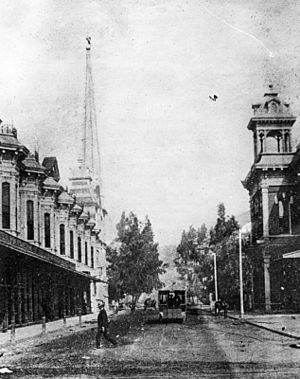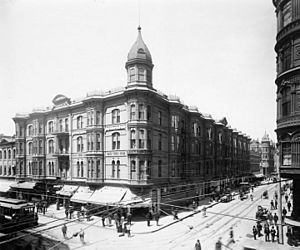John Edward Hollenbeck facts for kids
John Edward Hollenbeck (born June 5, 1829 – died September 2, 1885) was an American businessman and investor. He played a big part in developing Nicaragua and the city of Los Angeles, California in the 1800s.
Early Life and New Skills
J. Edward Hollenbeck was born in Hudson, Ohio. Later, his family moved to Winnebago County, Illinois. He didn't go to school much. In 1846, he decided he didn't want to be a farmer. With his father's permission, he left home to find his own way. After earning money from day labor, he went back to Ohio. There, he learned to be a machinist with Bell and Chamberlain in Cuyahoga Falls. He became a skilled worker in three years. But he chose not to become a partner in their business.
Adventures in Nicaragua
Instead of staying in Ohio, young Hollenbeck decided to travel. He wanted to go to the California gold fields. He took a ship from New Orleans to Aspinwall, which is now Colón, in Panama. But when he arrived, the next ship he was supposed to take broke down. While waiting, he got a fever. He was too sick to continue his trip. So, he sold his ticket for California.
The areas around Panama and Nicaragua were growing fast. This was because of a travel route owned by American Cornelius Vanderbilt. His company, the Accessory Transit Company, moved thousands of travelers. They went from the Atlantic to the Pacific side of Central America. These travelers were on their way to the gold rush in San Francisco. Ships traveled from New York and New Orleans to Greytown, Nicaragua. From there, small boats took passengers up the San Juan River and across Lake Nicaragua. Then, mules or stagecoaches carried them over land. They would reach San Juan del Sur, Rivas on the Pacific. There, they would get on ships going to California.
After getting better, Hollenbeck became an engineer on a steamer. This boat traveled up the Chagres River. He kept working on steamers that went to Greytown, Nicaragua and up the San Juan River. Around 1852, Hollenbeck started several businesses in Nicaragua. In Greytown, he offered entertainment to travelers. At Castillo Rapids, he opened a general store. He also won a contract to cut wood for the San Juan River steamers. In 1853, he bought the Nicaragua Hotel at Castillo Rapids. He renamed it the American Hotel. He ran it until it was burned down in 1857. In January 1854, he married Elizabeth Hatsfeldt. She was from Mainz, Germany and managed the hotel.
However, Greytown's economy was hurt in 1854. The United States Navy ship USS Cyane attacked and burned the town. This was in response to actions against American citizens. This event was reported worldwide. Soon after, the San Juan River changed its path, damaging the town again. Greytown was rebuilt and started to do well again.
In 1855, an American named William Walker took control of Nicaragua. He was a "filibuster," meaning he led private military expeditions. Walker canceled the Accessory Transit Company's rights and took its property. Hollenbeck and his wife had to leave their home before an attack in 1857. This attack destroyed their village by fire. Walker was later forced out by other Central American countries. In May 1857, Hollenbeck was rewarded for his loyalty. He received a government contract. He also got the former Transit Company house to replace his burned hotel.
Walker tried to take Nicaragua again in November 1857. He and his followers entered Greytown harbor. Some of his men raided Castillo Rapids. They took Hollenbeck and his wife as prisoners. The couple was held for two weeks up the San Juan River. Then they were moved to Lake Nicaragua for two more months. During this time, their store, house, and goods were burned. US Marines and Nicaraguan forces soon captured Walker. Hollenbeck and his wife were freed.
With their property destroyed, the couple decided to go to Illinois. Their only son, John Edward Hollenbeck Jr., had been sent to his grandparents there. But when they reached New York, they learned their two-year-old son had died from diphtheria. They returned to Greytown. Hollenbeck rebuilt his general store. He also bought a river steamer from the struggling Transit Company.
In 1860, Hollenbeck thought about moving back to the United States. He briefly lived in Missouri. But the coming American Civil War caused big economic problems. So, he and his wife returned to Greytown in 1865. Soon after, he became an agent for Royal Mail ships. He also worked for an English mining company. He shipped many products like rubber, wood, hides, coffee, and indigo. Around 1872, the Transit Company closed its operations in Nicaragua. Hollenbeck and three partners bought all the company's property.
Building Los Angeles

In 1874, Hollenbeck was a wealthy man, but he had health problems. He and his wife visited Los Angeles, California. The city was growing fast. Businesses were investing a lot of money. This was because the Southern Pacific Railroad was expected to arrive soon. While visiting California, Hollenbeck bought several pieces of land. He also put money into a local bank. Hollenbeck soon closed his businesses in Nicaragua. He made his final move to the United States. Before leaving Nicaragua, the government made him their special representative to the United States. He visited Washington, D.C., to handle business for Nicaragua.
Hollenbeck arrived in Los Angeles in early 1876. He bought land on the east side of the Los Angeles River. He built a large home with wide porches and a tower on a big piece of land on Boyle Avenue. By 1880, he had bought 27 properties. He spent $108,875 for a total of 6,738 acres (2,727 ha). His land included 600 acres (240 ha) south of the city, much of it planted with vineyards. In the San Gabriel Valley, he owned orange, lemon, and grape orchards. He also invested in 3,500 acres (1,400 ha) of Rancho La Puente. This was a ranch for grain and livestock. In 1884, he bought and developed a business area in Los Angeles. It was known as the Hollenbeck Block. This included the Hollenbeck Hotel.
Hollenbeck was elected to the Los Angeles Common Council on December 3, 1877. This was the city's governing body. His term ended on December 6, 1878.
In 1878, Hollenbeck became a shareholder in the Commercial Bank of Los Angeles. He was also elected its president. In 1881, he and other investors started the First National Bank. In 1880, Hollenbeck worked with former California Governor John G. Downey. They also worked with plant expert Ozro W. Childs and others. They convinced the State of California to buy 160 acres (65 ha) in Los Angeles. This was to help farming in the southland. This property was called Agriculture Park. Today, it is known as Exposition Park. It is home to the Los Angeles Coliseum and museums. On July 2, 1883, Hollenbeck received an American passport to travel abroad. It said he was 5 feet 8.5 inches (1.74 m) tall, with blue eyes and a light skin color. He last appeared on the Los Angeles City Electors List on August 4, 1884. His job was listed as farmer.
His sister, Susan Abiah Wells, married James George Bell.
Legacy
- Hollenbeck Canyon Wildlife Area
- Hollenbeck Park
- Hollenbeck Division Los_Angeles_Police_Department


